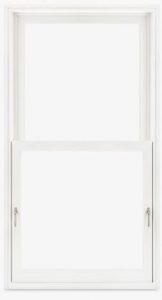
9 Popular Types of Windows for Homes
9 Popular Types of Windows for Your Home
Windows are an essential element of every home. The type of window that you choose helps define the style of your house. Whether your taste is traditional, transitional, modern, or contemporary – there is a window style that will fit your aesthetic. They provide natural light and keep out the elements. Plus, windows give an opportunity to add detail and beauty to your home while preserving and protecting your investment. This window guide will help you learn about the types of windows for homes available so that you can make the best decision for your project. Want to take it to the next level? Check out our post on Energy-Efficient Windows in Rhode Island!
When it comes to window replacement and installation, Red House is a company you can count on. With an experienced and expert staff, we can accurately diagnose the real condition of your existing windows. Our honest and reliable services have earned us our reputation as the trusted window installation and replacement services providers in Rhode Island and Southeastern Massachusetts. Our team will help guide you toward the best windows for your home.
What Are the Parts of a Window?
Before we dive into different types of windows for homes, it is important to understand the terminology that defines the main parts of a window:

Frame – A window frame is attached to the house and surrounds and supports the entire window. It is comprised of the head, jamb, and sill.
Head – The head is the horizontal top of a window frame. We usually measure the window height from the head to the sill.
Jamb – Jambs are the vertical sides of a window frame.
Sill – A sill is the horizontal bottom of a window frame.
Stile – The stile of a window is the vertical side component of a window frame or sash, providing structural support and housing the glass panes.
Apron – A window apron is the horizontal trim or molding located beneath the window stool (interior sill). It helps cover the joint between the wall and the window frame, adding a decorative finish to the window’s interior.
Sash – The sash is the moveable part of a window that holds the glass.
Rails – Rails are horizontal parts of a window sash; a bottom rail and a top rail.
Mullion – The mullion is a major structural piece running either vertical or horizontal that combines two or more windows together. (The two windows are “mulled” together).
Muntin – A muntin is a small bar that separates two or more pieces of glass in a window sash. Their origin is very old – from when glass could not be made in large sizes without breaking.
Grilles – Grilles are decorative pieces that visually divide window panels, giving the glass the appearance of multiple glass panes (aka a group of fake muntins), or “divided lites”.
Trim/casing – On the outside of a house, the decorative frame around a door or window is called trim, while on the inside, the same thing is called casing.
Double-Hung Windows
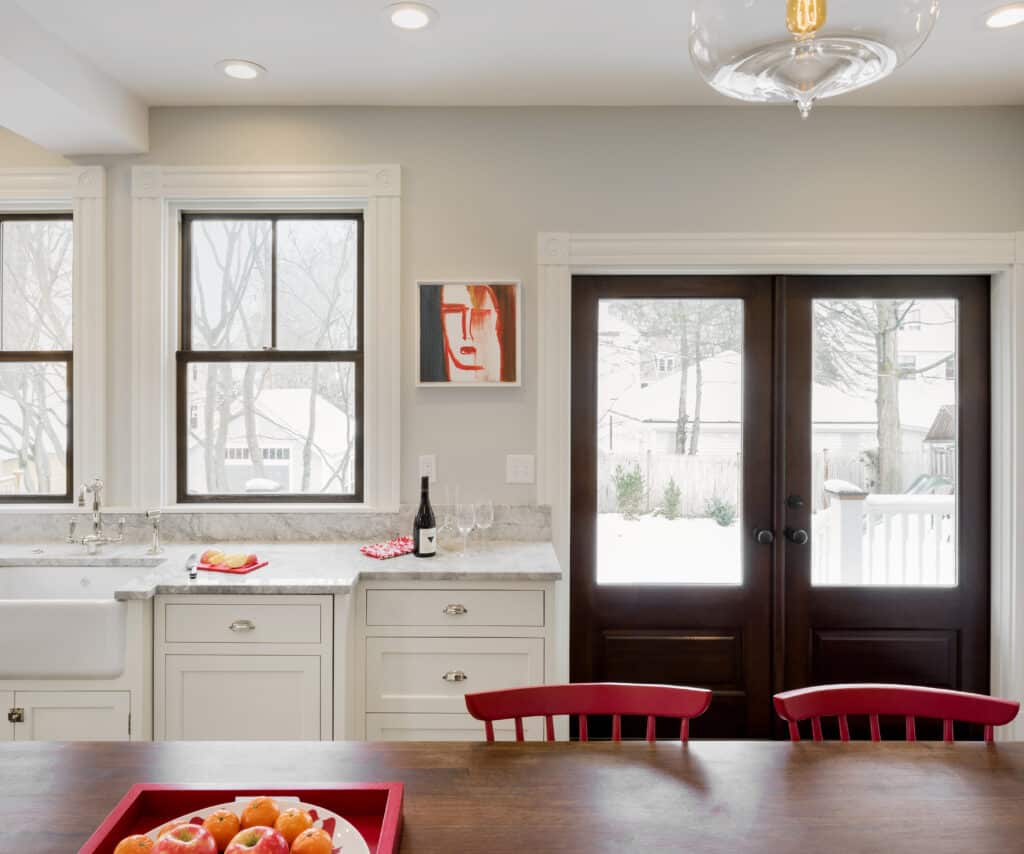
Photography: Aaron Usher III
Double-hung windows are the most popular type of window among homeowners. A double-hung window has two moveable sashes which means you can lower the top or raise the bottom. A big advantage for these windows is the ability to open the window from the top. This can be beneficial for a number of reasons including letting heat out more efficiently as it rises. In turn, having the bottom portion open as well will allow cool air to enter, the window essentially creates a circulation of air. Having your windows open from the top can create a wonderful cross breeze across your home without feeling like the windows are open. Many homeowners say they like this option for pets and children as well, opening the top portion of the window will avoid anything or anyone from falling out, this has been a more prominent consideration with homeowners. Another feature that homeowners love about double hung windows is how easy they are to clean. With the option to open from the top and bottom, you can easily get to any exterior marks that may otherwise be hard to reach on other window styles. Double-hung windows are used most often in traditional-style homes. These types of windows are widely manufactured, so your selection will be extensive. This also makes double-hung windows an affordable window solution.
Things To Consider About Double Hung Windows
CONS
- Energy Efficiency: Double-hung windows may not seal as tightly as other types like casement windows, potentially leading to higher energy loss and reduced insulation.
- Maintenance: The sashes and tracks can accumulate dirt and debris, requiring regular cleaning to ensure smooth operation. The moving parts, such as the balance mechanism, may also need periodic maintenance or repairs.
- Limited Ventilation: While they do provide ventilation, the opening is usually only half the window’s size at any given time, which can limit airflow compared to other window types like casement or awning windows.
- Potential for Air Leakage: The design of double-hung windows, with two operable sashes, can create more potential points for air leakage compared to single-hung windows or fixed windows.
PROS
- Easy Cleaning: Many double-hung windows have tilt-in sashes, making it easy to clean both the interior and exterior surfaces from inside the home, which is particularly useful for upper-floor windows.
- Aesthetic Appeal: Double-hung windows have a classic and timeless look that complements a wide range of architectural styles, from traditional to modern.
- Space-Saving Design: Since double-hung windows open vertically, they do not protrude into the exterior or interior space, making them ideal for areas with limited room for window operation.
- Safety Features: The ability to open the upper sash while keeping the lower sash closed can provide ventilation while maintaining safety, especially in homes with children or pets.
Are Double Hung Windows the Right Choice?
There are multiple advantages for choosing a double hung window style in your home. From their cost effectiveness, ease of cleaning, and ventilation uses, these windows are always a fabulous choice. A double hung window is actually one of the most common designs for personal spaces with high traffic like living rooms and kitchens. Be sure to weigh all of the pros and cons for incorporating double hung windows into your home and be sure to consider all factors for what makes sense for your home.
Single-Hung Windows
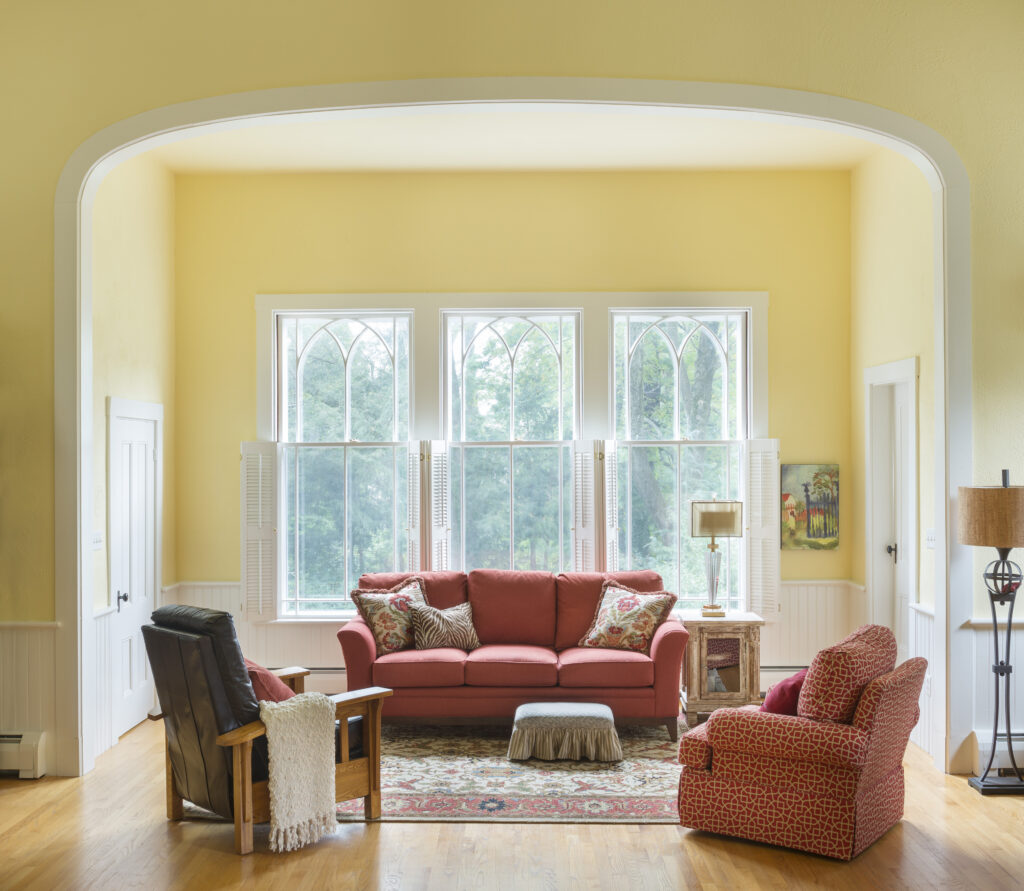
Photography: Aaron Usher III
Single-hung windows are a classic and common type of window featuring two sashes, one on top of the other. In this design, only the bottom sash is operable and can be moved up and down, while the top sash remains fixed. This type of window is easy to operate due to its simple vertical sliding mechanism. Single-hung windows are versatile and can be installed in various settings, including new construction and replacement projects, and they come in different frame materials such as wood, vinyl, aluminum, and fiberglass. They are often more cost-effective than double-hung windows and can offer better energy efficiency due to fewer moving parts, which reduces the potential for air leakage.
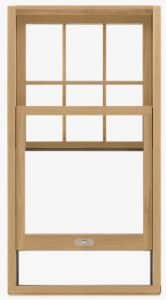
Things To Consider About Single Hung Windows
CONS
- Limited Ventilation: Since only the bottom sash can be opened, single-hung windows offer less ventilation compared to double-hung windows, where both sashes can be opened.
- Cleaning Challenges: Cleaning the exterior of the fixed upper sash can be difficult, especially on upper floors, as it cannot be moved or tilted inward like some double-hung windows.
- Restricted View: The fixed upper sash can obstruct the view, limiting the amount of natural light that enters the room compared to windows with both operable sashes.
- Less Versatility: The inability to open the top sash means less flexibility in controlling airflow, which can be a disadvantage in managing indoor air quality and temperature.
- Potential for Damage: The moving parts of the lower sash can wear out over time, leading to potential issues with operation and maintenance.
- Aesthetic Limitations: The design of single-hung windows may not suit all architectural styles, and some homeowners might prefer the look and functionality of other window types.
PROS
- Cost-Effective: Generally, single-hung windows are more affordable than double-hung windows, making them a budget-friendly option for new construction and renovation projects.
- Energy Efficiency: With fewer moving parts and a fixed upper sash, single-hung windows often provide better insulation and reduced air leakage, contributing to improved energy efficiency.
- Ease of Operation: The simple design of a single-hung window, with only the lower sash moving up and down, makes it easy to operate and less prone to mechanical issues.
- Traditional Aesthetic: Single-hung windows offer a classic and timeless look that complements many architectural styles, from historic homes to modern designs.
- Space-Saving: Because they open vertically, single-hung windows do not protrude outward or inward, making them ideal for spaces where exterior or interior clearance is limited.
- Durability: With fewer moving parts, single-hung windows tend to have fewer components that can wear out or break, leading to potentially longer-lasting performance.
Are Single Hung Windows the Right Choice?
Choosing the right type of window depends on various factors, including your specific needs, preferences, and the characteristics of your home. Single-hung windows can be an excellent choice if you are looking for a cost-effective option, as they are generally more affordable than double-hung or other types of windows. They can also offer good energy efficiency due to their fewer moving parts and the fixed upper sash, which helps reduce air leakage. If you prefer a traditional and classic look, single-hung windows can complement various architectural styles. Additionally, if you have limited space around your windows, single-hung windows are ideal because they open vertically and do not protrude into the interior or exterior space. With fewer moving parts, single-hung windows can be more durable and require less maintenance compared to other window types.
However, single-hung windows might not be the best choice if you need maximum ventilation, as double-hung windows or casement windows might be better suited for allowing both sashes to open. Cleaning the exterior of single-hung windows on upper floors can be challenging since the upper sash is fixed, while double-hung windows with tilting sashes make cleaning easier. If an unobstructed view and maximum natural light are important to you, consider other window types that offer larger openings or movable upper sashes. If you need more flexibility in airflow control and window operation, double-hung or other types of windows might be more suitable. Ultimately, the decision should be based on weighing these factors against your specific needs and preferences. Consulting with a window professional can also provide valuable insights tailored to your situation.
Slider Windows
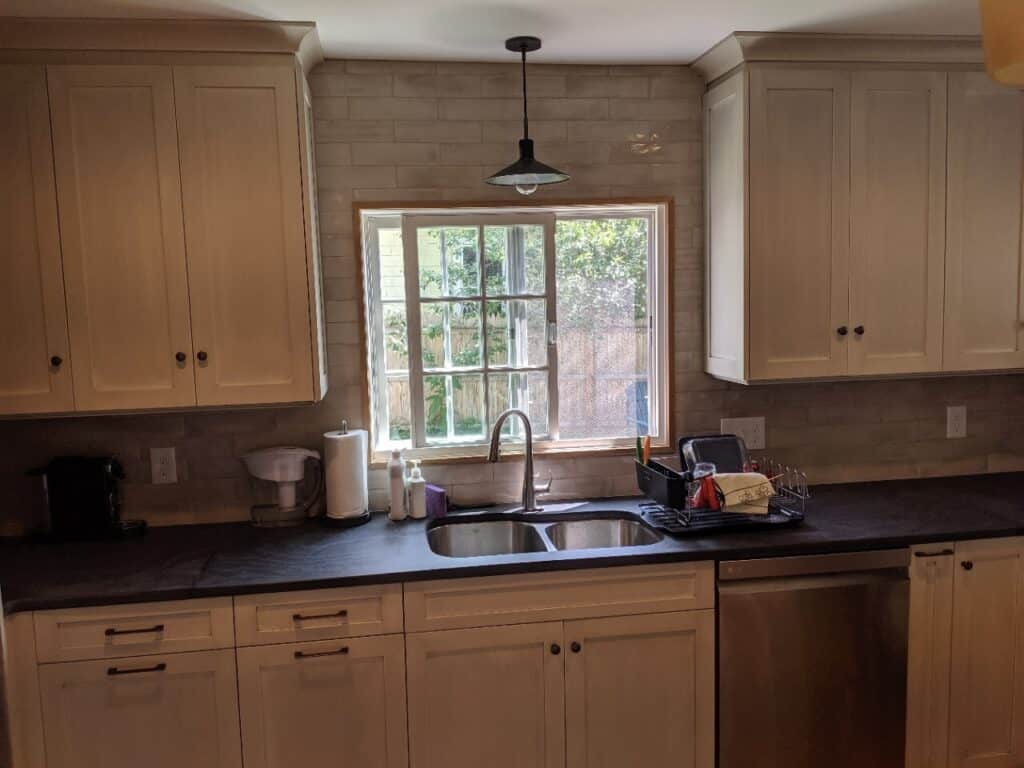
A slider window, also known as a sliding window, is a type of window that opens horizontally by sliding along a track. Typically, it features two or more sashes, with one or more sashes that can slide to the left or right. Slider windows are known for their simplicity and ease of operation, requiring minimal effort to open and close.
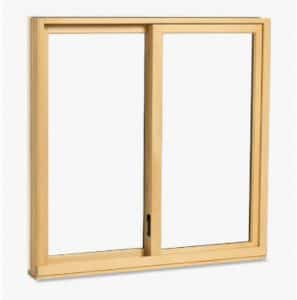
They provide a wide, unobstructed view and allow for ample natural light and ventilation. Slider windows are often used in spaces where vertical window operation might be impractical, such as over a kitchen sink or in a room with limited vertical space. They are available in various materials, including vinyl, aluminum, and wood, and are relatively low maintenance due to fewer moving parts. However, they may have potential drawbacks such as less effective sealing compared to casement windows, which can impact energy efficiency.
Where to Place Sliding Windows
- Living Rooms: Sliding windows are popular in living rooms for their expansive views and ease of operation. They provide ample natural light and ventilation, making them ideal for enhancing the comfort and ambiance of the space.
- Patios and Decks: Sliding windows are commonly used to connect indoor living spaces with outdoor areas like patios or decks. They create a seamless transition between indoor and outdoor living, allowing for easy access and enhanced airflow.
- Kitchen: Sliding windows are practical in kitchens where countertop space is located beneath or near the window. They offer convenient access for passing food and dishes between the kitchen and outdoor dining areas.
- Bedrooms: These windows are suitable for bedrooms where large openings and easy operation are desired. They provide good ventilation and views while maintaining security and privacy.
- Basements: Sliding windows can be installed in basements to provide natural light and ventilation. They are often used in spaces where larger windows may not be feasible due to limited wall space or underground placement.
- Home Offices: Sliding windows can be installed in home offices to enhance natural light and airflow, creating a comfortable and productive work environment.
Things To Consider About Sliding Windows
CONS
- Energy Efficiency: Sliding windows may not seal as tightly as other window types, such as casement windows, potentially leading to higher energy loss and reduced insulation.
- Maintenance: The tracks can accumulate dirt and debris, requiring regular cleaning to ensure smooth operation. Over time, the rollers and tracks may wear out, necessitating repairs or replacements.
- Limited Ventilation Control: Only one side of the window can be opened at a time, which can limit the amount of ventilation compared to double-hung or casement windows that can open fully.
- Security Concerns: Sliding windows can be easier to force open compared to other window types, making them potentially less secure unless additional locks or security measures are installed.
- Cleaning Challenges: Cleaning the exterior side of the fixed pane can be difficult, especially on upper floors, as the sash does not tilt inwards.
- Size Constraints: Larger sliding windows can be heavy and more difficult to operate, and they may require stronger framing and support, increasing the overall cost.
PROS
- Ease of Operation: As long as size allows, they are easy to open and close by sliding horizontally along a track, requiring minimal effort and making them suitable for areas where reaching or lifting might be challenging.
- Wide Views and Natural Light: Sliding windows typically feature expansive glass areas, providing unobstructed views and allowing plenty of natural light into the room.
- Space-Saving Design: Since sliding windows open horizontally, they do not protrude into the living space or exterior, making them ideal for areas with limited space or where outdoor clearance is a concern.
- Ventilation: While not as versatile as double-hung windows, sliding windows still offer good ventilation by allowing one or more sashes to be opened partially or fully, depending on the design.
- Modern Aesthetic: They have a sleek and contemporary appearance that can complement modern architectural styles and minimalist designs.
- Versatility in Design: Sliding windows are available in various materials such as vinyl, aluminum, and wood, offering options that can match the aesthetic and functional needs of different homes.
- Low Maintenance: With fewer moving parts compared to some other window types, sliding windows generally require less maintenance and upkeep over time.
Are Sliding Windows the Right Choice?
Casement Windows
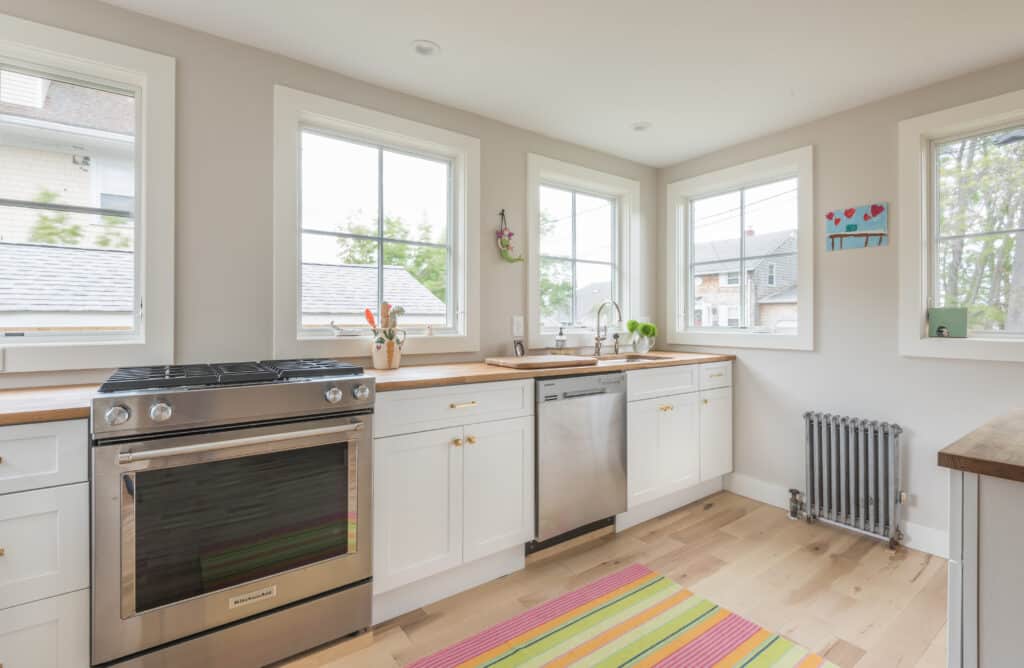
Photography: Aaron Usher III
Casement windows are hinged at the side and open outward like a door, operated by a crank mechanism. They offer several advantages, including excellent ventilation due to their ability to open fully, creating a large opening that can catch breezes effectively. Casement windows also
provide a tight seal when closed, which enhances energy efficiency by minimizing air leakage. Their design allows for unobstructed views and ample natural light,
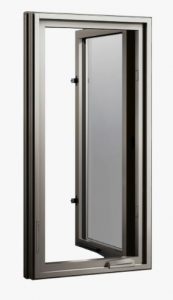
making them popular in both traditional and modern architectural styles. However, they require more clearance around them for opening outward, which may limit their use in certain spaces. Casement windows are available in various materials, such as wood, vinyl, aluminum, and fiberglass, catering to different aesthetic preferences and maintenance needs. Overall, they are valued for their functionality, energy efficiency, and aesthetic appeal in residential and commercial applications. Casement windows are a good choice for transitional or contemporary style homes. It is smart to be aware that when fully extended, casement windows can be broken off by strong winds.
Things To Consider About Casement Windows
CONS
- Clearance Space: Because casement windows open outward, they require ample exterior space. This can be problematic in areas where space is limited, such as near walkways, decks, or other structures.
- Wind Vulnerability: When fully opened, casement windows can catch the wind like a sail, making them vulnerable to damage in strong winds or storms. This can potentially stress the hinges and the frame.
- Maintenance of Mechanisms: The crank mechanism and hinges used to open and close casement windows can wear out over time, requiring maintenance or replacement. These components are more complex than the sliding mechanisms of other window types.
- Cleaning Difficulty: While the interior side of casement windows is easy to clean, the exterior can be challenging to reach, especially on upper floors, since the windows do not tilt inwards.
- Air Conditioning Units: Installing window air conditioning units in casement windows is typically not feasible due to their design, which can be a limitation in homes without central air conditioning.
- Cost: Casement windows can be more expensive than other window types, such as double-hung or single-hung windows, due to their more complex operating mechanism and higher-quality seals.
- Security Concerns: When left open, casement windows can be more accessible to intruders. While they typically close tightly and are secure when shut, additional locks may be needed to ensure security when open.
- Wear and Tear: Frequent opening and closing can lead to wear and tear on the hinges and seals, potentially impacting the window’s long-term durability and performance.
PROS
- Excellent Ventilation: Casement windows open fully, allowing for maximum ventilation. They can catch side breezes and direct fresh air into the home more effectively than other window types.
- Energy Efficiency: Casement windows close tightly with a strong seal, reducing air leakage and improving energy efficiency. This helps maintain consistent indoor temperatures and can lower heating and cooling costs.
- Unobstructed Views: With no horizontal sash, casement windows provide a clear, unobstructed view, allowing more natural light into the room and offering a better connection to the outdoors.
- Ease of Operation: The crank mechanism makes casement windows easy to open and close, which can be especially beneficial for hard-to-reach areas, such as over kitchen counters or furniture.
- Enhanced Security: When closed, casement windows offer excellent security due to their hook-shaped locks embedded within the frame, making them difficult to force open from the outside.
- Aesthetic Versatility: Casement windows come in various styles and materials, such as wood, vinyl, aluminum, and fiberglass, which can be customized to match the architectural design and aesthetic of your home.
- Weather Resistance: Casement windows seal tightly when closed, offering better protection against harsh weather conditions, including strong winds and heavy rain.
Are Sliding Windows the Right Choice?
Awning Windows
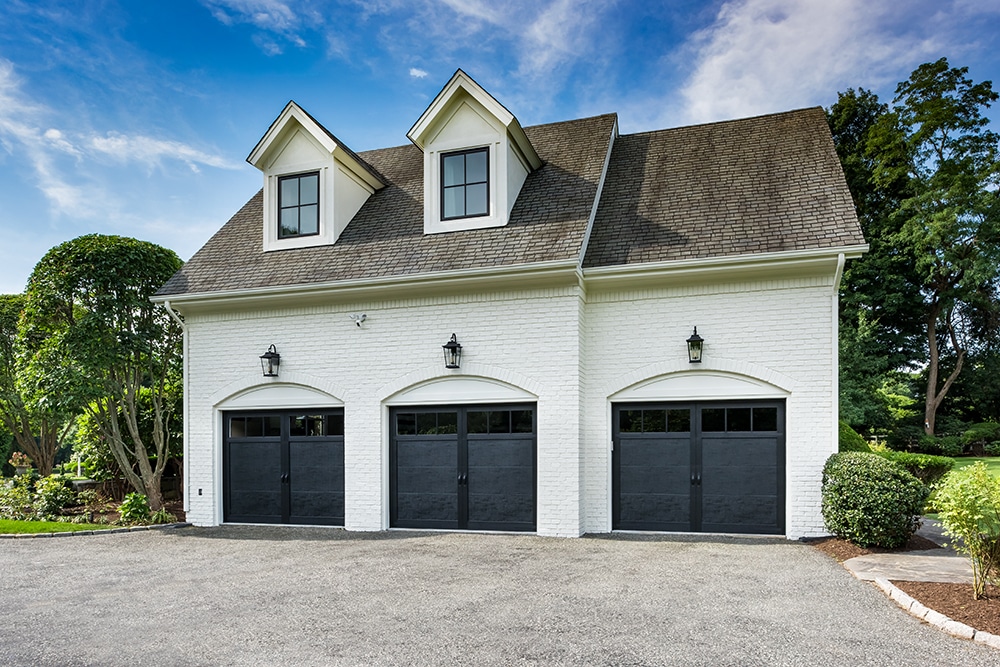
Photography: Aaron Usher III
Read more about this exterior project here
Awning windows are a charming and practical choice for any home, bringing a blend of functionality and style that’s hard to beat. Imagine a window that opens outward from the bottom,
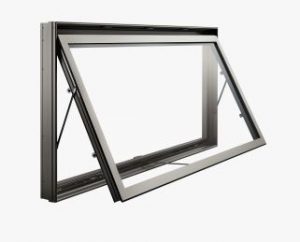
creating a delightful little roof-like awning. This clever design isn’t just for looks—it’s perfect for those rainy days when you want fresh air without letting in the rain. The top-hinged setup ensures that your home stays dry while still benefiting from a refreshing breeze. But the perks of awning windows don’t stop there. Their ability to be placed high on walls means you can enjoy continuous ventilation while maintaining your privacy. Plus, with their tight seal when closed, awning windows are champions of energy efficiency, helping to keep your home cozy in the winter and cool in the summer by minimizing air leakage.
One of the standout features of awning windows is their single-pane design, which offers clear, unobstructed views. This means more natural light floods into your home, creating a bright and inviting atmosphere. Whether you’re looking to brighten up a cozy reading nook or add a touch of elegance to your kitchen, awning windows can do the trick.
Of course, there are a few things to consider before installing awning windows. Since they open outward, you’ll need to ensure there’s enough exterior space, which might be a concern in areas with limited clearance. Cleaning the exterior can also be a bit of a challenge, especially for windows on upper floors. And while they’re secure when closed, you’ll want to take extra precautions to ensure they’re not left open when you’re away, as they could be more accessible to intruders.
Where to Place Awning Windows
- Kitchens: Awning windows placed above countertops or sinks can enhance ventilation while cooking and provide natural light without compromising privacy.
- Bathrooms: These windows are excellent for bathrooms, offering ventilation while maintaining privacy, especially when placed higher on the wall.
- Basements: Awning windows can be installed in basements to improve ventilation and natural light, as they can remain open even during rain without letting water inside.
- Utility Rooms: Rooms such as laundry rooms or utility closets benefit from awning windows for ventilation and light, particularly in spaces where larger windows may not be practical.
- Bedrooms: Depending on the layout and preferences, awning windows can be installed in bedrooms to provide ventilation and light while maintaining security.
- Living Rooms and Dining Areas: Awning windows can be strategically placed to improve airflow and natural light in these common areas of the home.
Things to Consider About Awning Windows
CONS
- Outward Opening Hazard: Awning windows open outward from the bottom, which can pose a hazard in high-traffic areas. People may accidentally run into them, potentially causing damage to the window or injury to themselves. This risk is especially significant near decks, patios, porches, sidewalks, or terraces where unexpected window protrusions can occur.
- Limited Emergency Exit: Unlike windows that slide open upwards, awning windows are not ideal for quick or safe emergency exits. Their outward opening mechanism may hinder rapid egress during emergencies. It’s important to consider local safety regulations regarding fire escape routes when installing these windows.
- Cleaning Challenges: Due to their slanted opening, awning windows can be challenging to clean thoroughly. Dusting and cleaning may require more effort and careful maneuvering to reach all areas effectively, which can be inconvenient for homeowners seeking easy maintenance.
- Ventilation: With a downward opening design, these windows won’t draw in as much fresh flowing air as other designs may offer. This should be considered when deciding on where these windows should be placed. Many homeowners will opt to place this type of window lower to the floor or towards the ceiling which may aid in a more effective airflow.
PROS
- Enhanced Ventilation and Lighting: Awning windows are designed to provide better ventilation and lighting compared to traditional sliding windows. They can remain open even during rain, allowing cool air to enter while keeping rain out. This feature enhances overall airflow and natural light within your home.
- Affordability: Awning windows are typically more affordable compared to other window options, making them a budget-friendly choice for homeowners looking to upgrade their windows without breaking the bank.
- Energy Efficiency: These windows contribute to energy efficiency by sealing your home against external weather conditions. They minimize air leakage better than traditional windows, helping to reduce heating and cooling costs throughout the year.
- Security: Awning windows enhance home security while offering good ventilation and lighting. Their design makes them difficult to break into from the outside, providing peace of mind for homeowners concerned about safety.
- Versatility in Design: Awning windows come in various materials, shapes, and sizes, offering versatility to match specific aesthetic preferences and functional needs. Whether you prefer wood, steel, fiberglass, aluminum, or vinyl frames, there are options available to suit different home styles and design preferences.
Are awning windows the right choice?
Awning windows can be the right choice for many homeowners seeking enhanced ventilation, affordability, energy efficiency, security, and versatile design options. They excel in providing better airflow and natural lighting, even during rain, due to their outward-opening design. Awning windows are typically more affordable than other window types, making them a budget-friendly option. They contribute to energy efficiency by sealing the home against weather conditions and offer enhanced security features. Available in various materials and styles, including wood, steel, fiberglass, aluminum, and vinyl, awning windows provide flexibility to match specific aesthetic preferences and functional needs. Consider these factors alongside your home’s layout and requirements to determine if awning windows are the right choice for you.
Hopper Windows
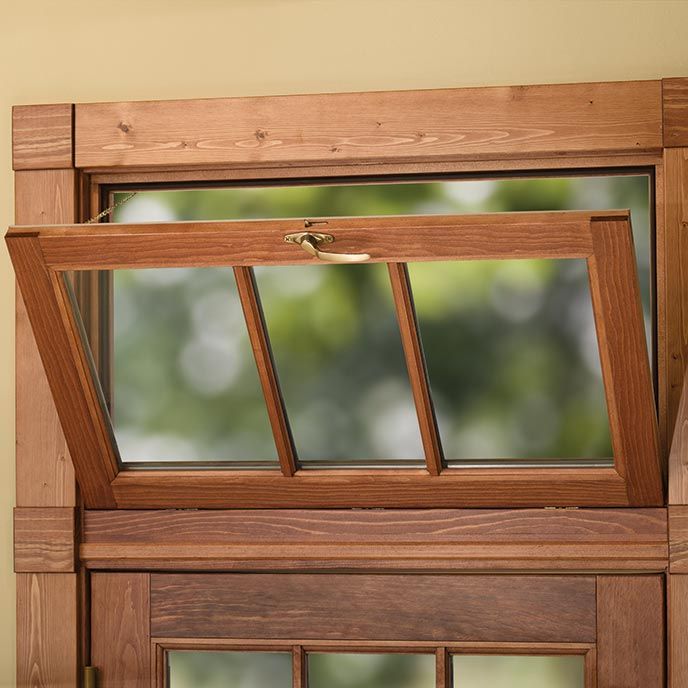
- Limited Ventilation: Due to their inward-opening design, hopper windows provide limited ventilation compared to windows that open outward fully, such as casement or awning windows. This restricted airflow may be a consideration in rooms where extensive ventilation is desired.
- Privacy Concerns: Depending on their placement and size, hopper windows may compromise privacy when opened, especially in ground-level or easily accessible areas. This can be a concern in bathrooms or bedrooms where maintaining privacy is crucial.
- Maintenance Challenges: Cleaning and maintenance of hopper windows can be more cumbersome due to their inward-opening mechanism. It may be harder to reach and clean both the interior and exterior surfaces, particularly in upper floors or areas with limited access.
- Accessibility Issues: In rooms with furniture or fixtures near the window, the inward-opening nature of hopper windows can pose challenges. They may interfere with the placement of items or restrict access to the window for opening and closing.
- Security Considerations: While hopper windows can be secure when properly locked, their inward-opening design may be perceived as less secure than windows that open outward. This could potentially pose a security risk if not adequately secured or monitored.
- Design Compatibility: Hopper windows may not aesthetically suit every architectural style or home design, as their appearance can be more utilitarian and less decorative compared to other window types.
PROS
- Ventilation: Hopper windows are designed to open inward from the top, allowing for efficient ventilation even during light rain or snow. This makes them ideal for basements, bathrooms, and utility rooms where ventilation is essential.
- Security: When closed, hopper windows provide a secure seal due to their inward-opening design and locking mechanisms. This feature enhances home security by making them more difficult to tamper with from the outside.
- Energy Efficiency: Hopper windows seal tightly when closed, minimizing air leakage and improving energy efficiency by preventing drafts. This can contribute to lower heating and cooling costs over time.
- Space-Saving: Their compact size and inward-opening operation make hopper windows suitable for smaller spaces or areas with limited exterior clearance, such as basements or bathrooms.
- Privacy: Hopper windows can be strategically placed higher on walls, offering natural light and ventilation without compromising privacy, making them suitable for bathrooms or ground-level rooms.
- Moisture Control: In areas prone to high humidity or moisture, such as basements or bathrooms, hopper windows help regulate indoor humidity levels by allowing for controlled ventilation.
- Versatility: Hopper windows come in various materials, styles, and sizes, offering versatility to match different architectural styles and design preferences.
Bay Windows
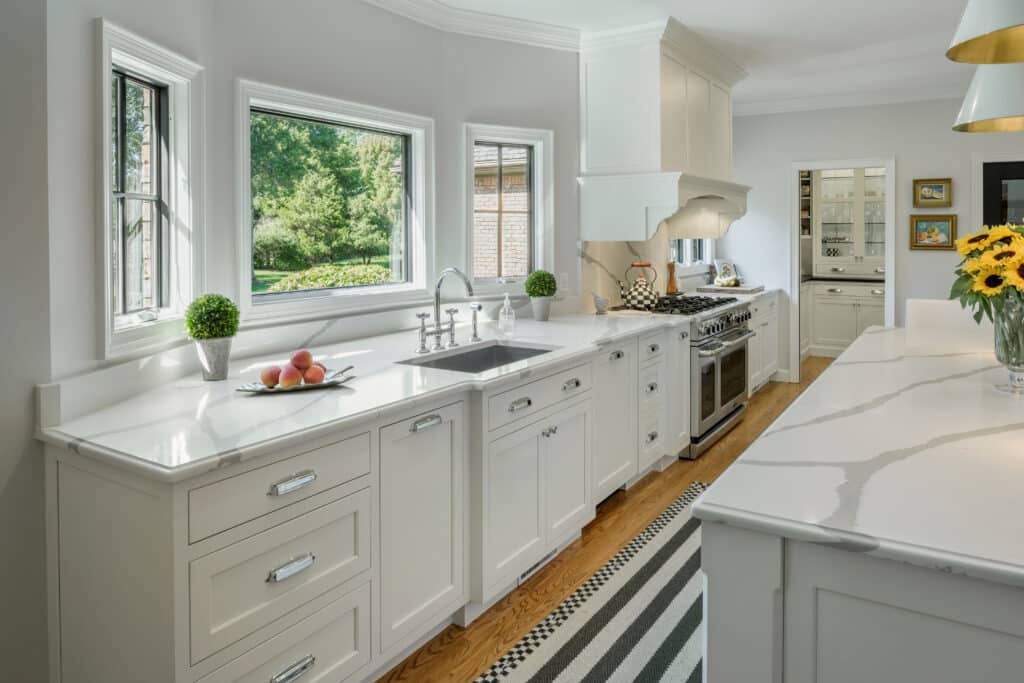
Photography: Aaron Usher III
Bay windows are architectural features that extend outward from the exterior wall of a building, creating a bay or alcove within a room. They have a historical legacy dating back to the

English Renaissance and gained popularity during the Victorian era for their aesthetic appeal and functional benefits.
In terms of design, bay windows typically consist of a central fixed or large window flanked by smaller windows on each side. These windows angle back towards the wall, maximizing natural light intake and providing panoramic views. This design enhances both the interior and exterior aesthetics of a home.
Functionally, bay windows offer several advantages. They significantly increase natural light, making rooms feel brighter and more inviting. They visually expand rooms, creating an illusion of additional space and openness. Bay windows also enhance the architectural interest and curb appeal of homes. Depending on their design, they can provide ventilation and airflow.
Bay windows are commonly recommended for placement in living rooms to create cozy seating areas or sunny reading nooks with panoramic views. They are also ideal for dining areas to enhance the ambiance during meals with natural light and outdoor views. In master bedrooms, bay windows serve as tranquil retreats with serene outdoor views for relaxation. They are also suitable for home offices to boost productivity with natural light and refreshing views.
When considering bay windows, homeowners should ensure they harmonize with the home’s architectural style, provide functional benefits like natural light and ventilation, and maintain privacy when needed. Integrating bay windows strategically into rooms can enhance both the aesthetic appeal and functionality of living spaces.
Placement Tips:
- Architectural Harmony: Ensure bay windows complement the overall architectural style of your home. They are often best suited to traditional or Victorian-inspired architecture, but can also work well with modern designs if integrated thoughtfully.
- Natural Light Optimization: Place bay windows where they can maximize natural light intake. Consider positioning them on south-facing walls to capture sunlight throughout the day, or on walls facing scenic views for added aesthetic value.
- Functional Considerations: Think about how you intend to use the space around the bay window. For instance, placing seating or a reading nook in front of the window can make the most of its panoramic views and natural light.
- Privacy and Views: Balance the desire for outdoor views with the need for privacy. Consider the external surroundings and how the bay window placement will affect privacy from neighboring properties or high-traffic areas.
Thing to Consider About Bay Windows
CONS
- Space Requirements: They require sufficient exterior wall space to protrude outward, which may limit placement options depending on the layout of your home.
- Maintenance: Cleaning and maintaining bay windows, especially if they include multiple operable sections or intricate framing, can be more challenging than standard windows.
- Temperature Control: Bay windows, especially those with large glass surfaces, may impact energy efficiency. They can result in more heat loss in winter and heat gain in summer compared to walls with less glass area.
- Privacy Concerns: Depending on the placement and surrounding environment, bay windows may compromise privacy, especially if they face neighboring properties or public areas.
- Security: The extended design of bay windows, with multiple panes and often large glass areas, may pose security risks if not properly secured or if located on lower floors accessible from outside.
- Design Limitations: Integrating bay windows into certain architectural styles or exterior designs may require careful planning to maintain aesthetic harmony with the rest of the home.
PROS
- Natural Light: Bay windows significantly increase natural light intake into a room, making spaces feel brighter and more spacious.
- Expansive Views: They provide panoramic views of the outdoors, enhancing the aesthetic appeal and allowing occupants to enjoy scenic vistas from the comfort of their home.
- Architectural Interest: Bay windows add architectural interest and curb appeal to a home’s exterior, often becoming a focal point that enhances its overall design.
- Interior Space: By projecting outward, bay windows create additional interior space, which can be used for seating areas, reading nooks, or decorative displays.
- Ventilation: Depending on their design, bay windows can be operational, allowing for effective ventilation and airflow to improve indoor air quality.
- Versatility: Bay windows are versatile and can be customized to fit various architectural styles and preferences, offering flexibility in design and placement.
- Increased Home Value: Well-designed bay windows can increase the resale value of a home by enhancing its aesthetic appeal, natural light, and overall livability.
Is a Bay Window the Right Choice?
Picture Windows
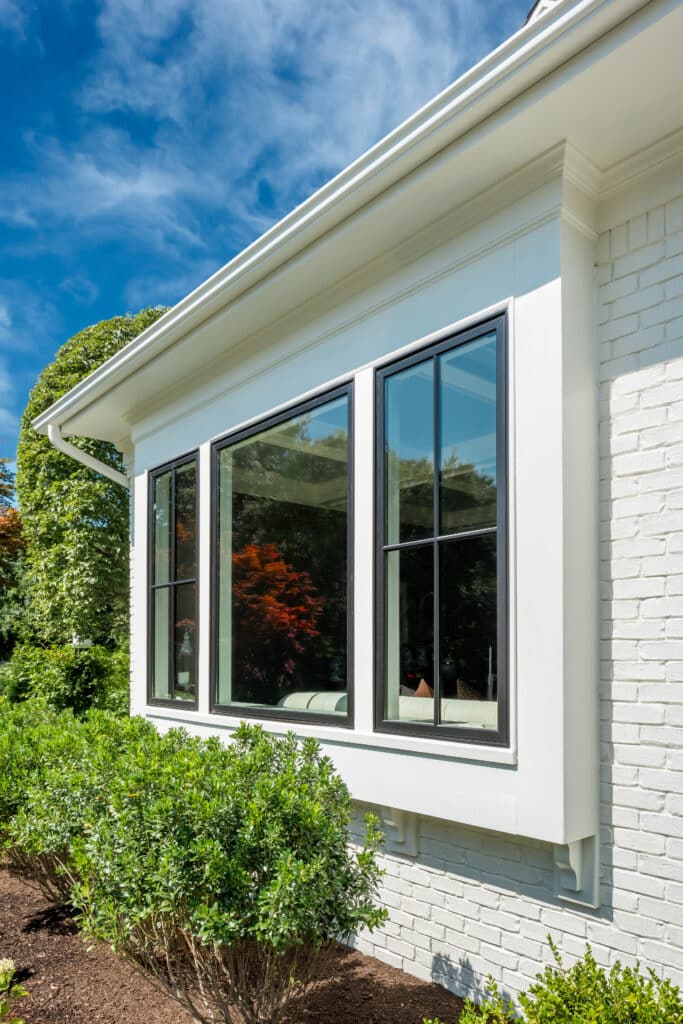
Photography: Aaron Usher III
Picture
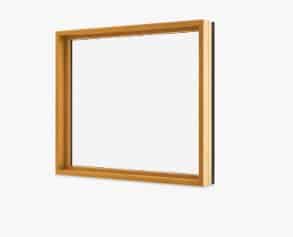
windows are large, fixed windows that do not open or have movable parts. They are designed to maximize natural light intake and provide unobstructed views of the outdoors. Picture windows are ideal for enhancing the aesthetic appeal of a room, serving as a focal point, and offering expansive views of landscapes or architectural features outside. They are commonly used in spaces where ventilation is not a primary concern but where maximizing daylight and views are desired, such as living rooms, dining areas, and rooms with scenic vistas.ews of the outdoors. They are used when ventilation and egress are not necessary. Due to the fact that they are sealed, they are the most energy-efficient of all windows. They provide an unobstructed panoramic view of the surrounding scenery.
Thing to Consider About Picture Windows
CONS
Lack of airflow – Homeowners may steer clear of picture windows because of the simple fact that they will not let air pass. Many homeowners place windows in their home to maximize airflow and create a more efficient heating or cooling system. Picture windows are well suited for spaces that do not face directly east or west where they would be getting excessive sun exposure. Think carefully when planning where to place your picture windows.
Heat Gain – As stated in the point above, picture windows may experience excessive sun exposure and it may be hard to control how much heat this window may let into your home on a hot summer day. If air ducts are placed near the windows too, it could be a very uncomfortable summer at home. This is why an experienced team is worth having to bring you through all of the possibilities.
Higher Potential for Breaks – Since picture windows are typically on the larger side, with no separation of sashes, one large piece of glass is much more suspectable to breakage. Be sure your picture windows feature shatterproof technology like tempering or safety films.
PROS
Natural Light – Larger than typical windows, picture windows are a great way to incorporate much more natural light into your home. Picture windows are ideal for sunrooms or spaces where walls are filled with windows.
Better Insulation – With no moving parts or small gaps for window openings, picture windows are ideal for rooms that need light and good insulation.
Easy to Clean From Inside – With fewer pieces of the window, these windows are much easier to clean. Picture windows often don’t even have panes which really makes these windows a quick and easy clean.
Less Prone to Fail – These windows are much easier to maintain as they do not have moving parts that will eventually fail. As long as some animate object doesn’t break your picture window, you can trust a picture window will last a very long time.
Is a Picture Window the Right Choice?
A picture window can be a fantastic addition to a room with a gorgeous view. With their large sizes it can really make a room feel dramatic. Their one piece build also makes them look much more sturdy and like a well thought out part of the wall. Picture windows can add a lot of architectural interest and appeal. There are many factors that should be considered though, when thinking about placing a picture window like the lack of ventilation and possibility for excessively heating a room and raising energy costs. Think through all of your wants and needs and figure out if a picture window is a good choice and where it may work best in your home. Ideally out of direct sun all day!
Fenestration in Historic Homes
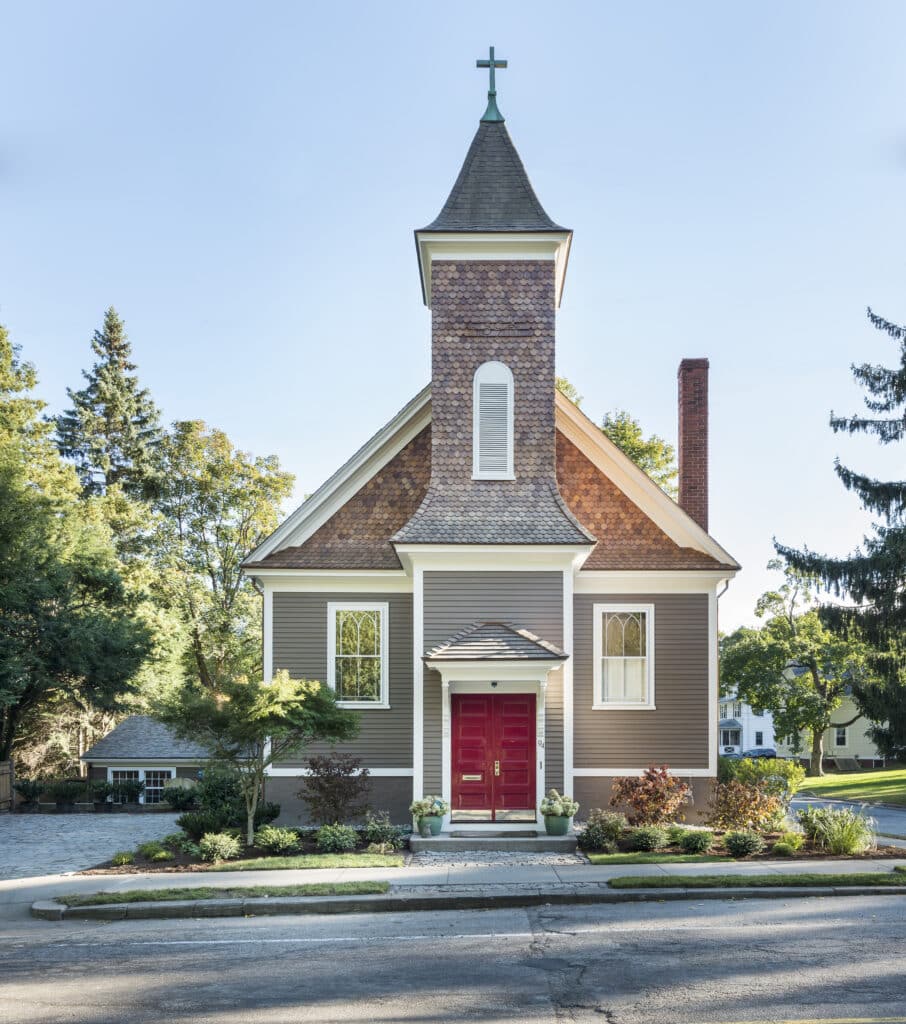
If you own a home located in a historic zoning district, you may have old windows you’d like to repair. The windows and doors of an old home contribute in a special way to its historic character. Historic District Commissions will often insist that you preserve the number, location, and size of a building’s windows and doors. Even if your windows have deteriorated, the replacement of all the windows in a historic building is seldom necessary and should be avoided.
Maintaining the original look of the fenestration, or the arrangement of windows and doors in a building, is vital to preserving the architectural heritage that most people love about historic districts. Commissioners will require contractors to try to renovate existing windows before approving any new-window plans. It’s important to work with a company that specializes in historic renovations. Contact us to learn more about our team of restoration specialists.
Rhode Island Window Replacement and Installation
We hope this overview of the types of windows for homes will help you understand which options might work best for your project. Windows are one of the most important parts of your home, and they deserve the utmost care and attention when selecting, maintaining, and replacing. At Red House, we only provide the highest quality products and services. Contact us today to learn more about replacing or upgrading your windows.
- Category : Exterior
- Type :


